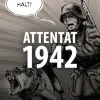Take a look inside 8 images
Attentat 1942
Pros: Well-produced, melancholic stories humanize historical events.
Cons: A bit too short to take full advantage of all the interesting mini-games.
Bottom Line: An absorbing experience that'll motivate students to piece together a family's story of survival during Nazi occupation.
Attentat 1942 is a great fit for classrooms since it doesn't take much time, and it does an excellent job of humanizing the tragedies and anxieties of normal people during World War II. This intense subject matter -- although packaged in a game -- is treated with respect and gravity thanks to excellent acting (including live-action video) and writing. A world history course or humanities course could easily incorporate Attentat 1942 as part of a larger unit on World War II or Nazi occupation and the persecution and oppression of people living under fascism. There's nuance to the story, presenting believable motivations for why common citizens chose to cooperate with an oppressive state -- an issue of continued relevance to political struggle. Supplementing play with classroom discussion or writing journals is probably necessary to help support student reflection and processing, both individually and with a group.
For classrooms that want to go even deeper, students could also be tasked with doing outside research about similar events. This complementary material could be presented in a slideshow, in an interactive timeline, or on a classroom website. These presentations could paint a larger landscape of similar stories about Nazi occupation and the rise of fascism. Pairing Attentat 1942 with deeper dives into fascism and bigotry, both historical and contemporary, would be useful as well. For those resources, teachers might turn to Teaching Tolerance or Facing History and Ourselves.
Attentat 1942 is a story-based game focused on uncovering a family's story of survival during World War II. The main character's grandfather -- a survivor of the war-- is in hospice care. With his grandfather ailing, the grandson wants to learn more about his family history. The game plays out a bit like a mystery, with the grandson talking to various people in and outside of his family, piecing together parts of the story -- from his family being separated by the Nazis to his father being sent to a concentration camp. The player chooses locations to visit on a map of the city, each leading to a series of live-action, first-person video interviews. This works kind of like the dialogue portions of a role-playing or adventure game. The player chooses a question to ask, watches a video of the person answering the question, and then chooses another question. Sometimes earlier choices become unavailable after a choice is made; usually talking to one person will open up an option to talk to another person.
Flashbacks occur at certain points in the story. These break from the live-action video and take the shape of an animated comic or mini-game. The activities vary from ordering the panels of a comic strip to finding hidden objects in a scene to just examining objects on a table.
Attentat 1942 is a mature game -- not only because the topic is mature, but also because it requires a mature attitude from players. For students to get the most out of the experience, they'll need to explore how the story is historically meaningful and important as well as a cautionary tale for today. Attentat 1942 sets up this learning opportunity, but it'll be up to educators to appropriately prepare students and facilitate post-play discussions and activities that draw these connections.
While it's an interesting, well-produced game, it's also relatively short. This is great in terms of classroom viability, but in terms of the game itself it means that the mini-games appear just once. Since some are relatively shallow, it would've been more compelling to repeat the best ones rather than change the puzzle mechanic each time. This is a minor quibble, though. In terms of difficulty, it's well-tuned for students of different skill levels. Nothing students do is particularly difficult, so everyone can finish, but those who do well get some extra story detail and depth. This is all tallied and displayed, encouraging players to play again if they want to get the full story.
















